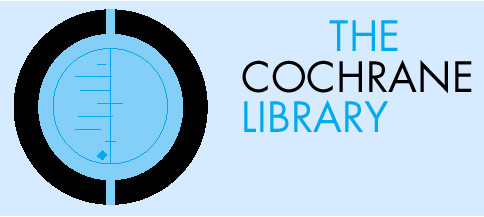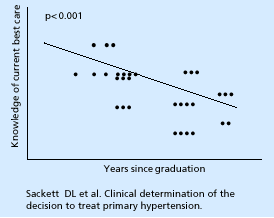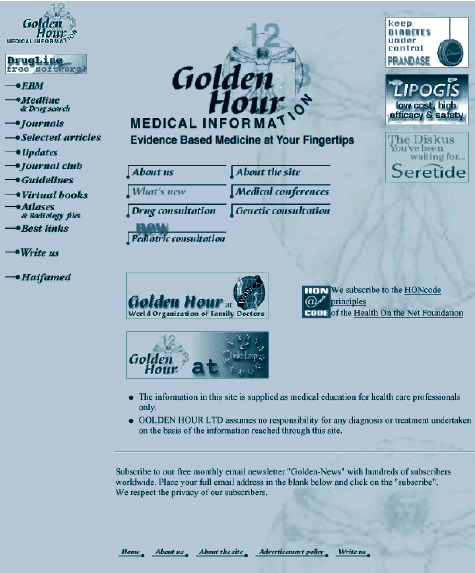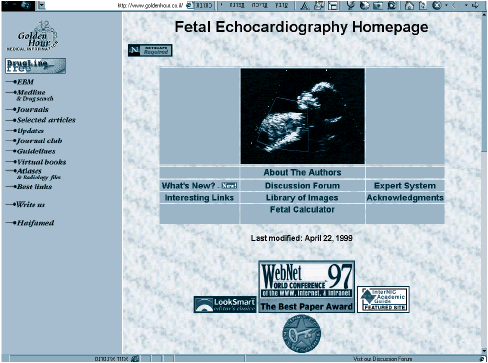Evidence-based medicine and the Internet
During the last decade, the production of medical information has doubled every 2 years. It is predicted that information will double at an even faster rate, i.e. every 1–3 months [1]. This dramatic rate of changing medical knowledge presents a challenge for physicians to keep themselves up to date.
During the last decade, the production of medical information has doubled every 2 years. It is predicted that information will double at an even faster rate, i.e. every 1–3 months [1]. This dramatic rate of changing medical knowledge presents a challenge for physicians to keep themselves up to date. Since accessibility to a medical library as a source of information is limited, the Internet may be a possible alternative. The Internet is a relatively cheap way to receive updated information, whether written, audio or videotaped, all of which is available from the comfort of home, 24h a day, at the cost of little more than a local telephone call.
Physicians are usually eager for the latest medical information. The late British epidemiologist, Archie Cochrane, developed a relatively new approach using up-to-date medical information. His approach integrates individual clinical expertise with the best available external clinical evidence from systematic research. Through this method new information is located, identified and its significance evaluated. If the new information has been proven to be reliable and relevant, it is integrated into existing information systems to be used by physicians all over the world. This approach is called evidence-based medicine (EBM) [2, 3].
The vision of Cochrane was put into practice soon after his death in 1988, through the Cochrane Collaboration, an international organisation that aims to help physicians (clinicians and policy makers) to make informed health care decisions by preparing, maintaining and promoting systematic reviews of the effect of health care interventions. In other words, rather than medical decisions being made on the basis of outdated information, a hunch or intuition, this approach allows the physician to review what has been shown to be effective and on that basis make an operative decision. EBM uses a simple scale to assign a level to the evidence (Table I). The best evidence is from systematic reviews which summarise randomised controlled trials (RCTs). The lowest level of evidence is expert opinion and the ‘personal communication’ source, also known as ‘someone once told me’.
Table I: Levels of evidence (based on AHCPR 1992).
Ia Evidence obtained from a meta-analysis of RCTs
Ib Evidence obtained from at least one RCT
IIa Evidence obtained from at least one well-designed, controlled study without randomisation
IIb Evidence obtained from at least one other type of well-designed quasi-experimental study
III Evidence obtained from well-designed, non-experimental, descriptive studies, such as comparative studies, correlation studies and case-control studies
IV Evidence obtained from expert committee reports or opinions and/or clinical experience of respected authorities.
The Cochrane Collaboration is a non-profit-making organisation, limited by guarantee and registered in the UK as a charity. Currently there are 15 Cochrane centres around the world and more than 50 collaborative review groups preparing and maintaining Cochrane systematic reviews. The database of the ‘Cochrane Library’ contains 1388 regularly updated systematic reviews, 300,000 RCTs, and critical assessment abstracts of good systematic reviews published elsewhere [4].
The OB/GYN discipline has contributed greatly to the establishment of the Cochrane collaboration and library. In 1987, the year before his death, Cochrane referred to a systematic review of RCTs of care during pregnancy and childbirth as ‘a real milestone in the history of randomised trials and in the evaluation of care’, suggesting that other specialities should copy the methods used [5]. The Cochrane Collaboration logo (Figure 1) illustrates this systematic review of data from seven RCTs.

Figure 1: The Cochrane Collaboration logo.
Each horizontal line represents the results of one trial (the shorter the line, the more certain the result), and the diamond represents their combined results. The vertical line indicates the position around which the horizontal lines would cluster if no clear difference was found between the two treatments compared in the trial. The position of the diamond to the left of the vertical line indicates that the treatment studied is beneficial.
The diagram shows the results of a systematic review of RCTs of a short, inexpensive course of a corticosteroid given to women expected to give birth prematurely. The first of these RCTs was reported in 1973. The diagram summarises the evidence that was to be presented a decade later: it indicates strongly that corticosteroids reduce the risk of babies dying from the complications of immaturity. By 1991, seven more trials had been reported and the picture in the logo had become even clearer. The treatment reduces the odds of premature infants dying from the complications of immaturity by 30–50%. Because no systematic review of these trials had been published until 1989, most obstetricians had not realised that corticosteroid treatment was so effective. As a result, tens of thousands of premature infants have probably suffered and died unnecessarily (and cost the health services more than was necessary). This is just one of many examples of the human costs resulting from failure to perform systematic, up-to-date reviews of RCTs of health care.
Is EBM really a new approach in the field of medicine or is it a routine activity already regularly performed by physicians?
The influx of new medical information well exceeds any physician’s ability to keep fully up to date. Covell et al. [6], in their article: ‘Information needs in office practice: are they being met?’, published in 1985, state that reliable information is needed in about two out of three physician-patient meetings at primary care clinics. Yet most physicians obtain the appropriate information in just 30% of those cases. The reasons for this divergence given by the research participants were:
‘My textbooks are out of date by the time they are published.’
‘My journals are too disorganised and not useful for routine information retrieval.’
'The influx of new medical information well exceeds any physician’s ability to keep fully up to date.'
How much time do we spend reading medical information?
Medical students typically spend as much as 2 h per week, probably in part because they do not have any choice, but most physicians and consultants spend far less than this. Up to 75% of house officers have not read anything about the problems presented by their patients in the previous week, and they are being taught by consultants up to 40% of whom have not recently read anything about the subject either [7].

Figure 2: Knowledge of current best care of hypertension: the slippery slope [8].
The slippery slope shown in Figure 2 depicts the progressive decline in knowledge-based clinical competency after the completion of formal training. Sackett et al. [8] demonstrated that when our skills are measured by our knowledge of even the fundamentals of a basic disorder, such as hypertension, there is a statistically and clinically significant negative correlation between our knowledge of up-to-date care and the years that have elapsed since our graduation from medical school. There are two reasons for this: first, we read less; and second, the amount of information is growing exponentially.
What can we do to stop the descent down the slippery slope?
Integrating the use of the Internet in a user-friendly way with EBM online resources can be helpful. A November 1999 issue of the British Medical Journal dealt with new technologies in medicine. One of the leading articles was about ‘cybermedicine’, a new academic speciality at the crossroads of medical information and public health [9]. Its goals are studying the application of the Internet to medicine and public health, examining the impact of the Internet on health care, and evaluating future opportunities and challenges for health care. The authors identify problems of the Internet as a source of information as: the quality of the online information, the lack of standards and the lack of social equity.
Currently there are more than 5 million websites, more than 320 million webpages, 150 million users, and more than 100,000 medical sites. The question is, how many of them are sufficiently reliable for health professionals to use? How can we find them? And which should we use for a particular problem?
The Haifa Family Medicine Department has initiated a programme combining the Internet with EBM. The object of the programme is to open up a pathway for as many physicians as possible to access updated medical information. The components of the project are set out below.
Courses for physicians
Courses comprise basic training for physicians (especially older physicians) in computer use, the necessary software and familiarity with the Internet. We have already run 60 courses involving 1500 physicians in Israel. All courses were conducted in special computer classes fully equipped to ensure an effective and enjoyable experience. The courses were taught by medical doctors with wide experience of the Internet, assisted by professional computer instructors. They concentrate on teaching physicians how to use the Internet as a working tool, by specifically teaching how to retrieve reliable medical information from the Internet in a timely manner.
EBM training
This comprises courses that teach the EBM way of thinking and how to apply EBM techniques. One of the leading courses is based on the idea of EBM as an essential tool for family physicians. The aims of the course are asking and solving common clinical questions, teaching the principles of EBM, and encouraging self-learning and searching for medical data.
A class of 30 family physicians was divided into three groups: each group had to look for a solution to the same specific question but in a different database set. The first group looked for data in textbooks, the second asked for experts’ opinions, and the third group looked for EBM data on the Internet. One week was allowed for searching and then a discussion meeting was held to compare the results. Answers were adopted according to the level of evidence prepared, and were then posted on the department website. At the end of the course the class was given a questionnaire that inquired about their satisfaction with the course, improvement in analysing medical problems, in self-learning and in critical reading of medical data. All participants reported improvement in all these parameters.
The bottom line for the whole project is the medical library, which is available through our website: http://www.goldenhour.co.il (Figure 3).

Figure 3: The www.goldenhour.co.il homepage.
The website in its current form is a huge information centre built from hundreds of links to reliable medical websites on the Internet, organised by nine topics visible on the left-hand side of the screen. The main topics are:
1. EBM: contains EBM search engines. There are nine complementary search engines, and a parallel search through each one of them can be very efficient. Examples are the TRIP database, indexing 28 databases of EBM information and providing links to evidence-based information through the Internet [10] and the Cochrane database [11], which is an electronic library resource with quarterly updates. It contains the collected work of the Cochrane collaboration in abstract format (obstetricians and gynaecologists can access the full text version through http://www.obgyn.net/cochrane.htm for free, after registration). Although it does not contain any unique medical information, it is a good starting point for finding evidence-based information on major controversial topics in medicine.
2. Medline and Drug Search [12]: free Medline search engines: Healthgate, Internet Greatfull Med, and PubMed. In 1999 there were 10.3 million Medline citations with approximately 32,000 citations added each month. Given the constant time constraints of clinicians’ schedules, physicians are often frustrated when attempting to do a literature search. Using Medline requires new skills and expertise and there is a different search strategy for articles dealing with treatment, diagnosis, prevention or prognosis. We highly recommend taking a course or personal tutorials in order to acquire the expertise to carry out qualitative evidence-based searches.
In this section there is also drug information, detailed information concerning diagnostic procedures and handy medical search engines.
3. Journals [13]: a long list of the known medical journals appearing on the web. Some are in full-text format and some are in abstract form only. The first journal to exploit the Internet was the British Medical Journal, which started publishing an electronic edition in parallel to the hard copy in April 1998. One can also find here the electronic edition of the American Journal of Obstetrics and Gynecology (abstracts/full text), the Journal of the American Medical Association Women’s Health Information Center in full text, the New England Journal of Medicine (abstracts/full text), and many other journals from various fields of medicine. We look forward to seeing more full-text journals in the near future.
Several secondary unique journals are available on the Internet providing summaries of the leading and important publications worldwide. These journals provide the study methods of the articles they review and the criteria for selecting the studies. One of the leading journals that meets these criteria is Bandolier, an electronic journal produced monthly in Oxford for the UK National Health Service Research and Development Directorate. It contains bullet points (hence Bandolier) of EBM. A sister publication concentrates on women’s health [14].
4. Guidelines [15]: contains all the medical guidelines ever published on the World Wide Web. Practice guidelines have proliferated in recent years and have been of variable quality and value, depending largely on the scientific accuracy of their development process. Recently, there has been a growing tendency to arrange the guidelines by levels of evidence, from systematic reviews to expert opinion (Table I).
5. Virtual books [16]: contains online medical books such as Merck Manual, Textbook of Orthopedics (Wheeles), books on radiology (x-ray, CT, MRI), dermatology and haematology.
6. Atlases [17]: comprises virtual libraries in anatomy, radiology and pathology. Among the most impressive are ‘Obstetric Ultrasound Online’ and ‘Fetal Echocardiography’ (Figure 4).

Figure 4: Fetal echocardiography website.
7. The Best Links section [18] is divided into several disciplines, since the number of medical sites is steadily increasing. In each discipline you can find the best links for other websites, with endless medical information.
Finally, beware of non-EBM information and be sure to re-evaluate any information obtained from an unfamiliar site.
“Beware non-EBM information and be sure to re-evaluate any information obtained from an unfamiliar site.”
A look to the future
As computer systems become widespread and easier to use in the clinic, the hospital and at home, the potential to access information when needed is enormous. For the present there is an immediate need for cooperation between information technology companies, physicians, publishers, policy makers and consumers in order to integrate the medical information system into a unified information network delivering frequently updated, clinically relevant, valid and evidence-based information.
When we have overcome these potential barriers, the rapid progress in technology will bring EBM straight to the patient’s bedside. Portable, small computers loaded with almost unlimited EBM information will be readily available to medical teams. It is quite realistic to expect that doctors will carry a portable, small computer with their stethoscope, and during their rounds in the department or clinic, will be able to key in a clinical question and receive a reliable answer within seconds.
Through our statistical web counter we have found that there has been a continuous increase in daily visits to our site, from 80 per day 18 months ago to 2000 per day during recent weeks. This ongoing feedback is an incentive to further develop our project. In view of the rapidity of technological development associated with the information explosion, the reality of the future may be beyond our vision.
References:
References
1. Shani M. The changing world [editorial]. Harefuah 1997; 133: 287.
2. Bennet JW, Glaziou P. Evidence-based practice: what does it really mean? Dis Manage Health Outcomes 1997; 1: 277â85.
3. Rosenberg W, Donald A. Evidence based medicine: an approach to clinical problem-solving. Br Med J 1995; 310: 1122â6.
4. http://www.update-software.com/ccweb/cochrane.cdsr.htm - (website no longer available).
5. Cochrane AL. Foreword. In: Chalmers I, Enkin M, Keirse MJNC, eds. Effective care in pregnancy and childbirth. Oxford: Oxford University Press, 1989.
6. Covell DG, Uman GC, Manning PR. Information needs in office practice: are they being met? Ann Intern Med 1985; 103: 596â9.
7. Sackett DL, Richardson WS, Rosenberg W, Haynes RB. Evidence-based medicine: how to practise and teach EBM. Edinburgh: Churchill Livingstone, 1997: 8â9.
8. Sackett DL, Haynes RB, Taylor DW, et al. Clinical determination of the decision to treat primary hypertension. Clin Res 1977; 24: 648.
9. Eysenbach G, Sa RE, Diepgen TL. Cybermedicine [interview]. Br Med J 1999; 319: 1294.
10. http://www.gwent.nhs.gov.uk/test-search.html
11. http://hiru.mcmaster.ca/cochrane/cochrane/cdsr.htm
12. http://www.goldenhour.co.il/medline.html
13. http://www.goldenhour.co.il/journals.html
14. http://www.jr2.ox.ac.uk/bandolier/booth/booths/women.html
15. http://www.goldenhour.co.il/guidelines_and_updates.html
16. http://www.goldenhour.co.il/virtual_books.html
S1E4: Dr. Kristina Adams-Waldorf: Pandemics, pathogens and perseverance
July 16th 2020This episode of Pap Talk by Contemporary OB/GYN features an interview with Dr. Kristina Adams-Waldorf, Professor in the Department of Obstetrics and Gynecology and Adjunct Professor in Global Health at the University of Washington (UW) School of Medicine in Seattle.
Listen
